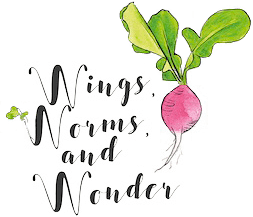Wonder Wednesday #25: Color Wheels of Nature
Wonder Wednesday #25: Nature’s Color Wheel
Happy Wonder Wednesday!
This Wonder Wednesday is extra special because I’m posting a lesson from my book! The Community Playthings blog is featuring an article I wrote on the importance of nature, art, and color for sparking wonder in childhood that includes the Nature’s Color Wheel lesson, and I want to share it with you!
Early childhood and K teachers, this is for you because I adapted the lesson from the original to gear it to younger children. 1-6 teachers, never fear, you will still find it useful because it is very easy to add research extensions and journaling activities to the color scavenger hunt.
Click here to read the full Community Playthings article. It’s a great foundation for incorporating art and nature across curricula. You will learn about Howard Gardner’s Naturalist Intelligence (the 8th of the multiple intelligences), research on childhood nature experience and how it develops adult environmental ethic, and even some fun nature based color theory.

Nature’s Color Wheel
Adapted from the book Wings, Worms, and Wonder: A Guide for Creatively Integrating Gardening and Outdoor Learning Into Children’s Lives by Kelly Johnson
Recommended children’s story: I am an Artist by Pat Lowery Collins
Materials
Access to a garden with a variety of colored plants that may be picked
Then choose if you will make a class color wheel:
- 24×24 inch heavy paper or an untreated plywood board (I created my color wheel on plywood because it is very durable and won’t blow in the wind.)
- Acrylic paint: red, yellow, blue, orange, green, purple, brown
- Paint brushes
Or choose to make individual color wheels:
- Create a color wheel template on paper (follow the style of the class wheel below using primary and secondary colors). Write “Colors of Nature” at the top if you would like.
- Colored pencils
Preparation
- Class Wheel: Using the acrylic paint, paint a large primary and secondary (red, purple, blue, green, yellow, orange) color wheel on the board. Outline the wheel in brown.
or
- Individual Wheels: Print off a color wheel template for each child and let them color it in before you head out to the garden.
Procedure
- Explain in this lesson we will be using our senses to practice our powers of observation. Explain what observation means and how it will help them discover nature’s colors on this scavenger hunt.
- Center the children in the space. Invite them to close their eyes, begin with two deep breaths, then slowly, lead them through the senses asking them to notice what they see, smell, hear, feel. When calling on each new sense, recenter with two deep breaths and say, “Send the mind into the…nose, ears, skin, etc.” This helps the child bring awareness to the sense. Offer a couple suggestions of what may be sensed, but leave room for personal discovery also. Remind them to answer the questions in their minds and that there will be time for sharing at the end.
- Once everyone appears to be relaxed and connected to the space, invite them to open their eyes. Present the color wheel and ask if anyone knows what this is. If the children are very young, they can name the colors. If you are using individual color wheels, pass them out and go over the colors.
- Explain that they will be seeking out items in the garden that represent each of the colors on the wheel. Clarify that they have permission to gently pick any items for this activity. The goal is to try to fill the colored triangles so that nature’s colors make up the wheel.
- Release them to forage for colors.
- When time is up, or the wheels are full, re-invite the group to join together. Engage in a discussion about what colors were easy to find (green) and what colors were more difficult (blue). Why were some colors difficult to find and others not? Was it because of the season or perhaps the type of garden? If actual blue is impossible, ask children where the largest blue item in nature is, the sky, and playfully invite them to pretend to grab a piece of sky and place it on the wheel. Allow time for the children to share their observations, discoveries, and creative thoughts. Sharing is crucial for assimilation of the experience and nature connections being made.
- If the group is still engaged, discuss the names of the items picked, if the items have a specific job in the garden, what plants are edible to humans and which are not, if they will change colors when they ripen, and any other unique characteristics or musings the colors of nature present!
Comments are closed.



So lovely! I’m going to try this. I can’t wait to get my hands on your book!
Thank you so much Veronika!! I shipped your book this morning, I hope you love it!!